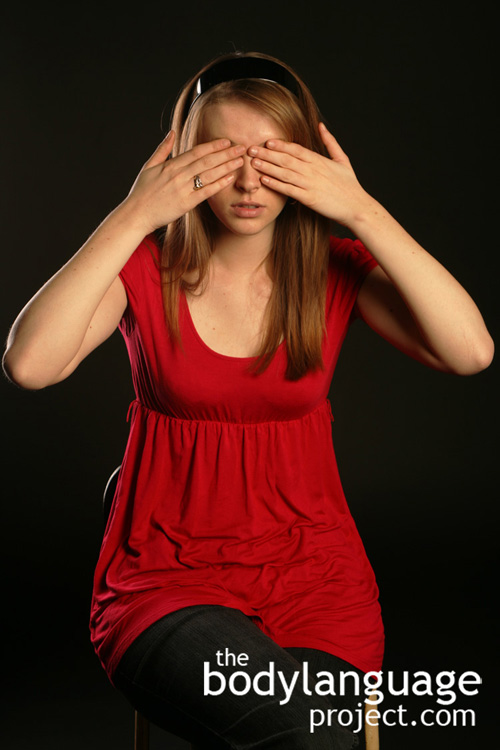
A childlike response to fearful stimuli is to block the eyes from seeing. Adults will use more subtle forms of eye blocking such as squinting.
A second related nonverbal behavior to the extended blinker is “eye-blocking” which is a term given to eyes that squint, shield or are covered by the hands or other objects. People cover their eyes when they feel threatened or don’t like what they see. My wife has a habit of covering her eyes (and blocking her ears) when horror movie previews suddenly appear on the television screen! Pupil size also related back to arousal and aggression. When we see things we like, our pupils dilate to allow the maximum amount of light in, but when we see something we don’t like, they immediately constrict. The same effect occurs when eyelids are constricted or squinted as they serve to reduce light hitting the eye. This brings objects into tighter focus allowing us to more clearly defend ourselves against an attack. Eye squinting related to tight focus is why we see people with less than perfect vision squinting to read when they are without their glasses. Incidentally, the same effect can be done by making a small hole in a piece of paper and reading through it, the effect will be to bring it back into focus by assisting the eye. Eye blocking can manifest itself in other ways too, sometimes just by accident. Restaurants that see it fit to place large center pieces in the middle of tables can present an interesting experiment. Does your company remove the item to get a better look at you so they can “take you all in” or to they keep it there to stifle the flow of conversations? I have a habit of discarding the center island especially if it’s useless and tall (or an ad to sell me expensive drinks!). I’ll even place it on a neighbouring table if convenient or on the seat next to me. I want to see my company, but do they want to see you?
Eye squinting or covering can be related back to a baseline to produce predictive powers. For example, while questioning someone about theft or vandalism, or any other event that brings back images that someone wishes not to recall, note when eyes become constricted. This will tell you which aspects of your recount makes them most uncomfortable. When vital information is struck, eye blocking in one form or another will surface. From there, it will be up to you to deduce the exact reason for eye blocking. Squinting can also flash as a microexpression in accompaniment of inconsistent body language to reveal true feelings. For example, smiling and waving to an acquaintance at a distance while squinting, shows that there is a poor connection and perhaps a subsurface distaste for them. Squinting can also be done while reading material that is disagreeable and will arise instantaneously without awareness. This is obviously a very useful ‘tell’ when negotiating contracts or devising plans. Other times eyebrows will lower instead of eye squinting, but the meaning is the same. Conversely, raised or arched eyebrows show positive feelings and high confidence.

